|
 Mycena ura Mycena ura
SynonymsGalactopus minatus
Galactopus miniatus
Mycena miniata
BiostatusPresent in region - Indigenous. Endemic
Images (click to enlarge)
Owner: Herb. PDD | 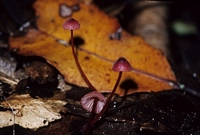
Owner: Herb. PDD | 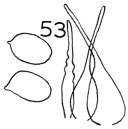 | 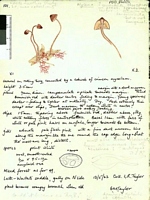
Caption: Watercolour
Owner: G.M. Taylor | 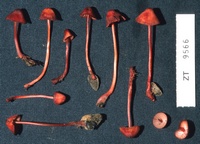
Caption: ZT9566
Owner: E. Horak: © Creative Commons Attribution-Noncommercial 3.0 New Zealand | 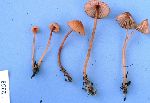
Owner: B.P. Segedin | 
Owner: B.P. Segedin | 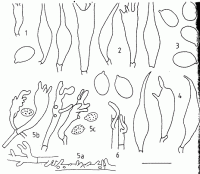
Caption: Fig.10 M. ura. 1. basidium. 2. cheilocystidia. 3. basidiospores. 4. pleurocystidia. 5a. repent pileipellis elements. 5b. erect pileipellis elements. 5c. "conidia". 6. emerging basal hairs. | 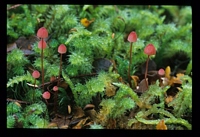
Caption: as Mycena (miniata)ura
Owner: Herb. PDD | 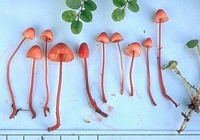
Caption: Lake Te Anau, South Island, 1999-04-15
Owner: Karl Soop | 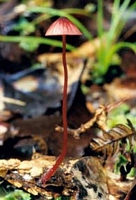
Caption: Mycena ura
Owner: Kaimai Bush | 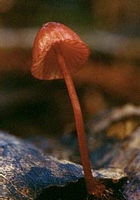
Caption: Mycena ura
Owner: Kaimai Bush | 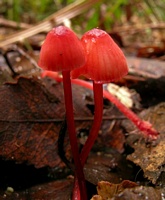
Owner: J.A. Cooper | 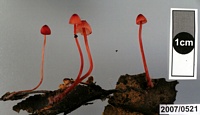
Owner: J.A. Cooper | 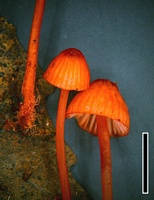
Caption: scale=2mm
Owner: J.A. Cooper | 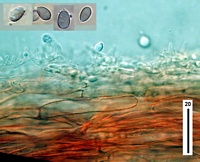
Caption: section through cap and spores (melzers)
Owner: J.A. Cooper | 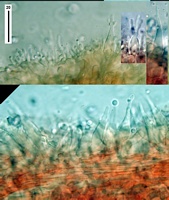
Caption: cheilocystidia. Note longitidinal hyphae.
Owner: J.A. Cooper | 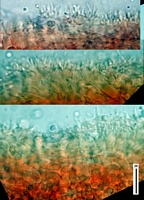
Caption: cheilocystida. Note longitudinal hyphae with excresences.
Owner: J.A. Cooper | 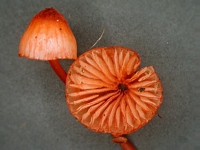
Owner: J.A. Cooper | 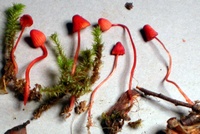
Owner: P. Leonard | 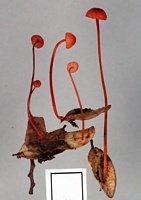
Owner: J.A. Cooper | 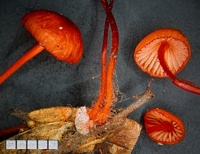
Owner: J.A. Cooper | 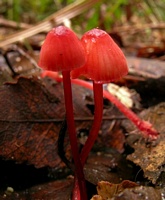
Caption: FUNNZ2007/0521
Owner: FUNNZ | 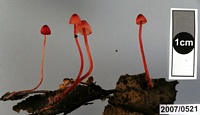
Caption: FUNNZ2007/0521
Owner: FUNNZ | 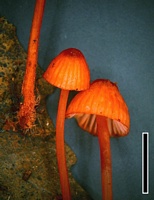
Caption: FUNNZ2007/0521
Owner: FUNNZ |
Article: Segedin, B.P. (1991). Studies in the Agaricales of New Zealand: some Mycena species in sections Longisetae, Polyadelpha, Rubromarginatae, Galactopoda, Lactipedes, and Calodontes. New Zealand Journal of Botany 29(1): 43-62 (http://www.rsnz.org/publish/abstracts.php).
Description: Microscopic characters of the holotype Spores 7.5-10 X 4.5-5.5 (8.5 X 5) µm. Q=1.7; ellipsoid,
fairly uniform in size and shape, hyaline, smooth, thin-walled, weakly amyloid,
with a somewhat prominent apiculus. Basidia 20-25 X 7-8 µm. 4-spored. Cheilocystia
40-50 X 9-12 µm., forming a very thick layer, ventricose-fusiform, sometimes
tapering sharply to a very narrow tip apically, occasionally with 2 or 3 necks
or with 3 or more apical/lateral protuberances, uniform in size and shape, with
brown (in KOH) plasmatic pigment (red in fresh material). Among the cystidia
are some vermiform hyphal endings with darker brown-staining contents, which
appear to be endings of the latex system. Pleurocystidia frequent, similar in
shape to the cheilocystidia but tending to be slightly longer, also with brown
(in KOH) plasmatic pigment. Trama of narrow (3 µm.) to inflated (-25 µm.) hyphae,
dextrinoid. Pileipellis elements repent, 2-3 µm. diam., with short, simple or
branched protuberances, with here and there clusters of ascending to erect,
clavate ends, 25-30 X 5-6 µm. at apex, with apical Finger-like processes up
to 3 µm. diam., sometimes almost forming a palisade. Associated with these elements
are small (3 X 4 µm), spore-like structures with dark reddish-brown, granular
contents, some with 1 or 2 narrow outgrowths (germ-tubes?). Subpellis of inflated
cells 25-30 µm diam. Context like the trama, with well-developed lactifers with
conspicuous, deep red contents. The stipe has cortical cells towards the base
with finger-like outgrowths, mostly simple, sometimes in clumps, infrequent,
and many lactifers. Clamp connections conspicuous.
Description of basidiome based on information from further collections
Pileus very variable in size from 3-20 mm diam., parabolic,
with slight umbo when young to convex with age, never flattening, brilliant
crimson, sometimes darker in centre to pinkish towards the margin, surface very
finely fibrillose under a lens (Fibrils darker red), dry, pellucid striate to
2/3 distance from the edge, margin smooth to unevenly crenulate when older,
becoming darker red with age; drying brick-red lo black, depending on fresh
state and speed of drying. Lamellae adnexed, ascending, in 3 series but irregularly
so (e.g., 1 long, 1 intermediate, 1 short, 1 long), up to 16 reaching the stipe,
pinkish, usually with a conspicuously red, fimbriate margin when fresh, although
colour may fade, medium width (2-3 mm), not crowded, somewhat ventricose. Stipe
15-55 X 2 mm, bright red (7E6), darker at base, paler above (dark where it joins
the cap), smooth, shining, hollow, even for most of length but slightly swollen
at the base which bears conspicuous, coarse, red hairs (colour retained on drying),
fragile, exuding blood red latex when broken; drying dark red to black. Taste
unknown, odour said to be of iodiform.
Microscopically,
there is some variability among the collections in the degree of branching both
of the apex of the cheilocystidia and of the elements of the pileipellis. Some
ventricose elements with very irregular apices among the cheilocystidia appear
to be the endings of lactifers, more swollen than those detected in the type
material. There seemed no evidence of caulocystidia or terminal cells, the stipe
cortex being smooth except for emerging hairs near the base. Clamp connections
were fairly frequent. The conidia-like bodies were found in most of the material
examined.
Habitat: HABITAT: Gregarious on litter, fallen twigs and branches
of Kunzea ericoides, Dacrycarpus dacrydioides, Dacrydium cupressinum
Lambert Podocarpus totara G. Benn. ex D. Don, Knightia excelsa
R. Br., and Nothofagus in lowland and montane forest.
Notes: ETYMOLOGY: ura is Maori for crimson red the colour pohutukawa
flowers (Metrosideros excelsa Sol. et Gaert.).
M. ura is
one of the commonly collected species of Mycena in New Zealand forests,
possibly rendered more conspicuous by its bright red colour. The lack of caulocystidia
and the persistently red stipe after drying makes the assigning of this fungus
to either of Maas Geesteranus sections Galactopoda or Sanguinolentae problematical.
Microscopically it has much in common wit. M. haematopus (Pers.: Fr.)
Kummer ( = "haematopoda") described by Maas Geesteranus (1988), but
macroscopically M. haematopus is a much more robust, drab-coloured fungus.
Singer (1969) believed M. miniata Stevenson might be the same as M.
haematopoda var. chilensis Sing. Horak (1983), in his discussion of the
fungal biogeography of the South Pacific, included M. haematopoda Pers.:
Fr. as a southern species but did not include M. miniata as a synonym
of it, evidently believing the latter to be a distinct species. Certainly his
description (1979) of M. haematopoda in Tierra del Fuego as sub fasciculate,
pale to dark dull vinaceous, lamellae whitish, with vinaceous juice, and of
the Chilean var. by Raitelhuber (1987) as dull chestnut or reddish chestnut
with chestnut juice, does not appear to relate to M. ura with its usually bright
red colours. The red colour of the pileus, the red juice, the red hairs at the
base of the stipe and the conidia-like structures associated with the pileipellis
are cry characteristic of this fungus.
Article: Horak, E. (1971). A contribution towards the revision of the Agaricales (Fungi) from New Zealand. New Zealand Journal of Botany 9(3): 403-462 (http://www.rsnz.org/publish/abstracts.php).
Notes: Mycena miniata Stevenson (29 D) = Galactopus miniatus (Stevenson)
comb. nov. (Basionym: M. miniata Stevenson, Kew Bull. 19: 54, 1964)
Article: Stevenson, G. (1964). The Agaricales of New Zealand: V. Kew Bulletin 19(1): 1-59.
Description: Pileus 3-7 mm diam., crimson, striate at edge, darker at centre, campanulate, moist, drying paler; flesh thin, crimson. Gills adnate, pink with crimson margins, moderately distant, long and short intercalated. Stipe 2-4 cm x 0.5-1 mm, crimson, translucent, solid, smooth with fibrils at base, producing sparse red latex on breaking. Spores 8 x 6 µm, amyloid, thin-walled. Hymenophoral trama and tissues of Pileus strongly pseudo-amyloid with many hyphae and cells over 10 µm diam. Cheilocystidia 40-60 x 5-15 µm more or less awl-shaped (Fig. 53).
Habitat: Attached to Nothofagus litter, Maitai Valley, Nelson, 29.4.1956, Stevenson (type); Catchpole, Wellington, 3.5.1958, Morva Sutch.
Notes: Like many small Mycena spp. this fungus is strongly geotropic. Specimens placed in a petri dish turn vertically in a few hours.
|